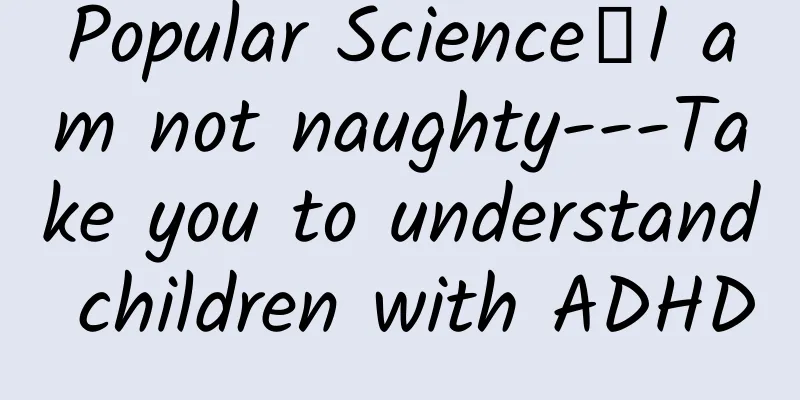Popular Science丨I am not naughty---Take you to understand children with ADHD

|
Some children often behave overactively in daily life, cannot sit still, are easily distracted in class, twist their bodies in their seats or even leave their seats without permission, lose things, are careless, have difficulty planning and implementing tasks, and have difficulty waiting in line. These behaviors may be manifestations of children's ADHD. These children are not deliberately naughty or disobedient, but their brains process external information differently from other children of the same age. Therefore, they need more understanding and support, appropriate treatment and help. Parents can try to communicate and interact more with their children, and seek advice from professional doctors to help their children better control their behavior. Let's get to know children with ADHD! 1. What is attention deficit hyperactivity disorder? ADHD, the full name of which is Attention Deficit Hyperactivity Disorder, is one of the most common neurodevelopmental disorders in children. It is characterized by inattention, hyperactivity, and impulsivity . In 66%-85% of children, ADHD may persist into adolescence and adulthood. The global incidence of ADHD in children is about 7.2%, and about 65% of children have one or more comorbidities. The prevalence of ADHD in children in my country is 6.26% (about 23 million people). ADHD not only impairs learning functions, but may also affect children's peer relationships and family parent-child relationships, and even cause emotional, psychological and sleep problems. 2. Early identification of ADHD 1. What is “inattention”? The time that normal children can concentrate varies at different ages, and as they grow older, their attention span gradually increases. An abnormality is only considered if the child's attention span is significantly shorter than the above and is significantly different from that of the majority of children in the class. 2. What is “hyperactivity”? (1) Frequent movement of hands and feet or twisting in seat (2) Frequently leaving seats when expected to stay in them (3) Frequent excessive activity in inappropriate situations (fidgeting) (4) Often have difficulty concentrating quietly on leisure activities 3. What is “impulse”? (1) Frequently answering questions before the speaker has finished speaking (2) Often have difficulty waiting in order (3) Frequently interrupting or disturbing others 3. Causes of ADHD 1. Abnormal brain development Abnormal brain structure and function, and dysfunction of chemicals such as dopamine and norepinephrine in the brain. 2. Other factors It mainly includes genetics, pregnancy and delivery factors, and environmental exposure. 4. What are the behavioral signs of ADHD at different ages? 5. What are the impacts of ADHD? 1. Learning dysfunction: Most children with ADHD have normal intelligence, but due to their inability to concentrate, they often have poor academic performance, unstable academic performance, and large fluctuations in academic performance, which becomes more obvious as they get older. 2. Difficulty in interpersonal relationships: Children with ADHD often behave in unpredictable ways and are prone to emotional outbursts, which can easily lead to conflicts and contradictions with others. Children are often criticized by their parents and teachers and rejected by their classmates, making it difficult for them to make good friends, which can lead to a loss of self-esteem and affect their school performance. 3. High incidence of accidents: Children with ADHD are born "adventurers". They act impulsively and lack forethought and planning. 50% of children with ADHD have a tendency to get into accidents. The risk of traffic accidents, drowning, etc. is greatly increased compared to ordinary children. 4. Comorbidity: More than 65% of children with ADHD also suffer from other developmental disorders and mental and psychological disorders. The most common ones are sleep problems and sleep disorders, language disorders, specific learning disabilities, tic disorders, anxiety and depression disorders, etc. 6. How to intervene in ADHD? The intervention methods are different for different age groups. (1) Children under 4 years old: Generally, children under 4 years old are not diagnosed with ADHD. If children under 4 years old have ADHD symptoms and it affects their social and psychological aspects, parent behavior management training (PTBM) is recommended. (2) 4-6 years old: Non-drug treatment is the preferred treatment, including psychoeducation, psychobehavioral therapy, special education and functional training, parent training and school intervention. (3)>6 years old: Comprehensive treatment combining drug treatment and non-drug treatment. There is no need to worry or panic about children with ADHD. Early identification and diagnosis, and long-term, personalized comprehensive treatment can help children optimize their learning/occupational functions, family functions, social functions and other functions as early as possible. References 1. Liu Jing, Zheng Yi. Interpretation of the second edition of the "Guidelines for the Prevention and Treatment of Attention Deficit Hyperactivity Disorder in China"[J]. Chinese Journal of Psychiatry, 2016, 49(3): 132-135. 2. Developmental Behavior Group of the Pediatrics Branch of the Chinese Medical Association. Pediatric expert consensus on early identification, standardized diagnosis and treatment of attention deficit hyperactivity disorder[J]. Chinese Journal of Pediatrics, 2020, 58(3): 188-193. END Author: Zhang Wenwen, Guo Haibin, Han Guangyan (Rehabilitation Center of Changzhou Children's Hospital) Reviewer: Kong Mian (Chengdu First People's Hospital, member of the Standing Committee of the Science Popularization Working Committee of the Chinese Rehabilitation Medicine Association) |
>>: This virus is spreading recently! 5 tips to protect yourself
Recommend
What period does the 5th day of menstruation belong to?
During menstruation, girls should be aware of the...
Flat breasts? It can save you!
Every female friend likes to have a pair of firm ...
Diagnosis and treatment of traumatic subarachnoid hemorrhage
Traumatic subarachnoid hemorrhage is a serious ne...
How to reduce milk supply if there is too much milk?
After giving birth, the first thing to worry abou...
Smallpox, which has ravaged the world for thousands of years, is the only infectious disease that has been eradicated by humans.
In medieval Europe, people often said that there ...
How much does the nine-valent vaccine cost?
Persistent infection with high-risk HPV viruses c...
How long can ovulation survive?
For married women, it is understandable that they...
Can enema cure pelvic inflammatory disease?
As one of the common gynecological diseases, the ...
What are the causes of menstrual disorders?
The phenomenon of menstruation coming a little ea...
What should I do if I feel nauseous 9 days after having sex?
Although modern society is more open than before,...
Can I eat donkey-hide gelatin if I have ovarian cysts?
Women will develop many gynecological tumors, inc...
Omdia: Global smart video surveillance market size to reach US$25.2 billion in 2022
According to Omdia estimates, the global intellig...
Can I repot the newly bought camellia immediately? When is the best time to repot the camellia?
Camellia is a kind of flower that we often see in...
What causes vaginal bleeding with back pain?
The vagina is a reproductive organ unique to fema...
What to do if pregnancy does not implant
Pregnancy is the combination of sperm and egg to ...









